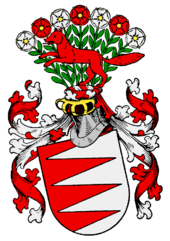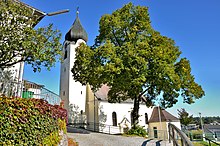Rohr Castle (Kremstal)
| Rohr Castle | ||
|---|---|---|
| Alternative name (s): | Veste pipe | |
| Castle type : | Hilltop castle | |
| Conservation status: | Burgstall | |
| Place: | Rohr in the Kremstal | |
| Geographical location | 48 ° 3 '58.4 " N , 14 ° 11' 19.7" E | |
|
|
||
The castle pipe , also Veste tube called, is an Outbound hilltop castle in village of the same pipe in Kremstal in Kremsmünster on a hill surrounded by a pond.
history
Rohr Castle was the seat of the Rohrers , who originally came from Bavaria and produced a number of important clerical and secular officials . The Rohrers were also relatives of the important Count Bebo von Abensberg (around 1002). According to Michael Wening, the Bavarian headquarters of the Rohrer im Rottal was a simple two-story building with small turrets.
In addition to the Bavarian line, there was another branch of the family in the Innviertel. 1138 "apud Rore" is mentioned in the traditions of the Ranshofen Abbey . Traditional names are Raffold von Rohr (1090–1140), Helmbrecht (around 1110) and Chadelhoch (1140 and 1141). His brother was called Chadelhoch the Tall One. Friedrich von Rohr's son Reicher became a clergyman. The second son Otto I (1142–1170) had three sons: Poppo (1150–1195), Raffold (1157) and Otto II (1170–1206). His son Otto III. is mentioned in 1207. He donated a farm in Stadlkirchen to the Gleink monastery in 1234 and the Kremshof to the Spital am Pyrn in 1234. In 1256 disaster broke out on Otto III. from: He was sitting with Ortlof von Volkersdorf and the sovereign scribe von Enns Witiko (Witigo), captain in the service of King Ottokar of Böhmen , at a board in St. Florian Monastery . During the meal a dispute broke out in the course of which Otto III. or Ortlof stab the Witiko. Otto was then punished with expulsion from the country and confiscation of his property. He fled to his relatives in Bavaria. Rohr Castle was destroyed by order of King Ottokar in 1256. The Rohrers then moved their headquarters to Leonstein , which was then destroyed in the so-called Rohrer Feud in 1390.
Under the Roman-German King Rudolf von Habsburg , the sons of Otto III, Hans (1277–1299) and Otto IV (1284–1295), are back in Upper Austria. In 1282, Hans received permission from Duke Albrecht to rebuild Rohr Castle (1284). Around 1303 the Rohrers sold their castle to the Roman Queen Elisabeth. Heinrich von Rappach, Richter zu Hall, is appointed burgrave. In the middle of the 14th century, Rohr was pledged to Berthold I von Losenstein. Duke Albrecht III. redeemed the castle in 1357, borrowing money from Dietmar von Aisterheim. In 1358 the castle was pledged to Helmhart Jörger . Rohr was finally destroyed in 1380.
As early as 1430 and 1495, Rohr was called the Burgstall , which completely disintegrated in the 15th century.
Rohr Castle today
In 1660 the abbot of Kremsmünster had the castle chapel removed and the church in Unterrohr built in its place (today the Catholic parish church of the Assumption of Mary ). A stone coat of arms of the Rohrer with the year 1577 was found in 1880, it is kept in Achleiten Castle.
From the remains of the castle, an inn was built next to the church.
literature
- Siegfried Haider : History of Upper Austria . R. Oldenbourg Verlag, Munich 1987, ISBN 3-486-54081-5 , p. 43 and 66 .
- Oskar Hille: Castles and palaces in Upper Austria then and now . Verlag Ferdinand Berger & Sons, Horn 1975, ISBN 3-85028-023-3 .
- Herbert Jandaurek: The castles and palaces, castle stables and fortifications in the Traunviertel. In: Upper Austrian homeland sheets . 18th year, issue 3 and 4, Linz 1964, p. 61 ( online (PDF) in the forum OoeGeschichte.at).
Individual evidence
- ↑ Walter Aspernig: The power-political changes in Kremsmünster in the 14th century and the history of ownership of Achleiten castle and rule in the Traunviertel from the beginning up to 1600. In: Yearbook of the Upper Austrian Museum Association. Volume 149a, Linz 2004, p. 442 ( PDF (3 MB) on ZOBODAT ).


